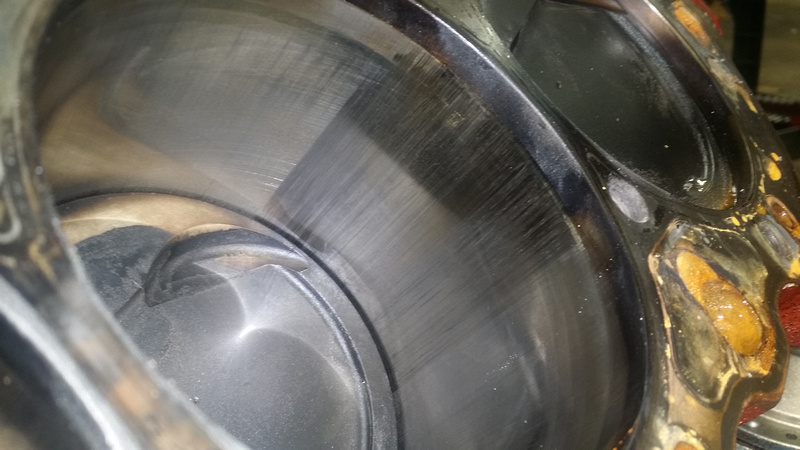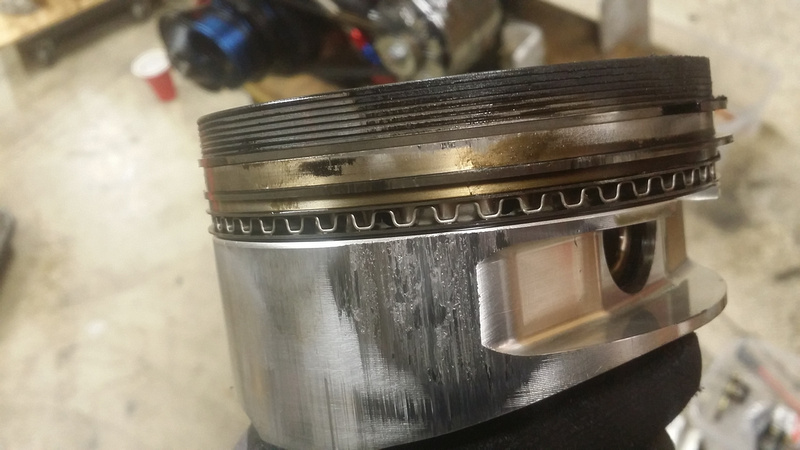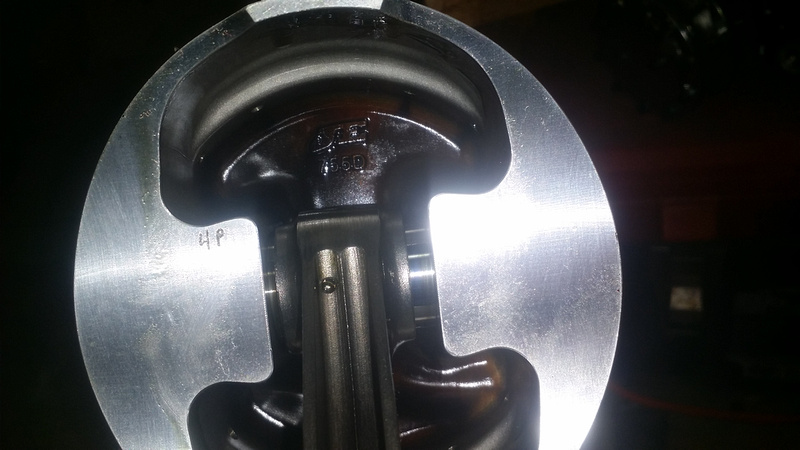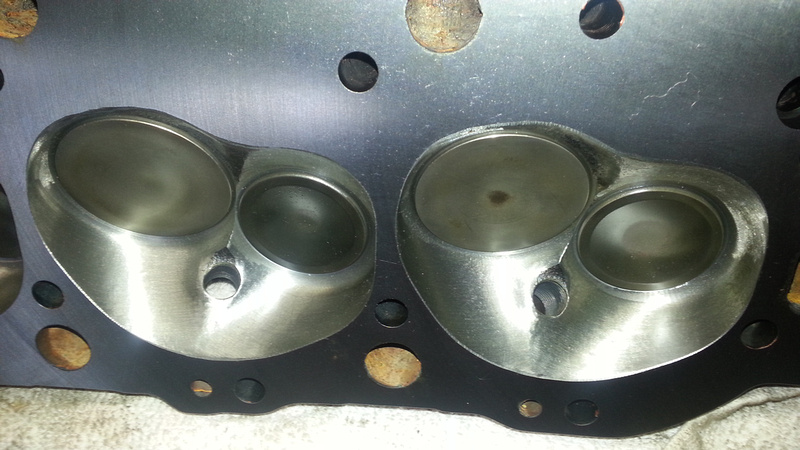Timing vs AFR vs EGT
#21
Registered
iTrader: (1)
About the Northstar :
Consider the Northstar engine. If you do a full throttle 0-60 blast, the engine will likely run up to 6000 RPM at a 11.5:1 or 12:1 air fuel ratio. But under sustained load, at about 20 seconds, that air fuel ratio is richened up by the PCM to about 10:1. That is done to keep the spark plugs cool, as well as the piston crowns cool. That richness is necessary if you are running under continuous WOT load. A slight penalty in horsepower and fuel economy is the result. To get the maximum acceleration out of the engine, you can actually lean it out, but under full load, it has to go back to rich. Higher specific output engines are much more sensitive to pre-ignition damage because they are turning more RPM, they are generating a lot more heat and they are burning more fuel. Plugs have a tendency to get hot at that high specific output and reaction time to damage is minimal.
A carburetor set up for a drag racer would never work on a NASCAR or stock car engine because it would overheat and cause pre-ignition. But on the drag strip for 8 or 10 seconds, pre-ignition never has time to occur, so dragsters can get away with it. Differences in tuning for those two different types of engine applications are dramatic. That's why a drag race engine would make a poor choice for an aircraft engine.
Consider the Northstar engine. If you do a full throttle 0-60 blast, the engine will likely run up to 6000 RPM at a 11.5:1 or 12:1 air fuel ratio. But under sustained load, at about 20 seconds, that air fuel ratio is richened up by the PCM to about 10:1. That is done to keep the spark plugs cool, as well as the piston crowns cool. That richness is necessary if you are running under continuous WOT load. A slight penalty in horsepower and fuel economy is the result. To get the maximum acceleration out of the engine, you can actually lean it out, but under full load, it has to go back to rich. Higher specific output engines are much more sensitive to pre-ignition damage because they are turning more RPM, they are generating a lot more heat and they are burning more fuel. Plugs have a tendency to get hot at that high specific output and reaction time to damage is minimal.
A carburetor set up for a drag racer would never work on a NASCAR or stock car engine because it would overheat and cause pre-ignition. But on the drag strip for 8 or 10 seconds, pre-ignition never has time to occur, so dragsters can get away with it. Differences in tuning for those two different types of engine applications are dramatic. That's why a drag race engine would make a poor choice for an aircraft engine.
#22
Platinum Member
iTrader: (6)
LOL.........



Last edited by F-2 Speedy; 11-19-2017 at 12:52 PM.
#24
Registered
iTrader: (1)
Many times you will see a piston that is scuffed at the "four corners". If you look at the bottom side of a piston you see the piston pin boss. If you look across each pin boss it's solid aluminum with no flexibility. It expands directly into the cylinder wall. However, the skirt of a piston is relatively flexible. If it gets hot, it can deflect. The crown of the piston is actually slightly smaller in diameter on purpose so it doesn't contact the cylinder walls. So if the piston soaks up a lot of heat, because of detonation for instance, the piston expands and drives the piston structure into the cylinder wall causing it to scuff in four places directly across each boss. It's another dead give-a-way sign of detonation. Many times detonation damage is just limited to this.


Engines that are detonating will tend to overheat, because the boundary layer of gas gets interrupted against the cylinder head and heat gets transferred from the combustion chamber into the cylinder head and into the coolant. So it starts to overheat. The more it overheats, the hotter the engine, the hotter the end gas, the more it wants to detonate, the more it wants to overheat. It's a snowball effect. That's why an overheating engine wants to detonate and that's why engine detonation tends to cause overheating.
lots of heat in that piston.

Current piston after a season of hard running looking good.



Engines that are detonating will tend to overheat, because the boundary layer of gas gets interrupted against the cylinder head and heat gets transferred from the combustion chamber into the cylinder head and into the coolant. So it starts to overheat. The more it overheats, the hotter the engine, the hotter the end gas, the more it wants to detonate, the more it wants to overheat. It's a snowball effect. That's why an overheating engine wants to detonate and that's why engine detonation tends to cause overheating.
lots of heat in that piston.

Current piston after a season of hard running looking good.

#25
Max timing not brought in until
525SC = 35* at 4500 RPM
600SC = 33* at 5000 RPM
800SC = 28* at 5000 RPM
Cruising timing at 3500 RPM approx
525SC = 30
600SC = 28
800SC = 24
Timing at 2500 (planing area )
525SC= 27
600SC= 22
800SC =20
Not sure where the whole concept of locking the timing , or "bringing it all in by 3000" came from for a supercharged marine engine. NA engine, I could see why they did bring it all in by 3000.
525SC = 35* at 4500 RPM
600SC = 33* at 5000 RPM
800SC = 28* at 5000 RPM
Cruising timing at 3500 RPM approx
525SC = 30
600SC = 28
800SC = 24
Timing at 2500 (planing area )
525SC= 27
600SC= 22
800SC =20
Not sure where the whole concept of locking the timing , or "bringing it all in by 3000" came from for a supercharged marine engine. NA engine, I could see why they did bring it all in by 3000.
#26
Registered
iTrader: (1)
Another thing you can do is increase the burn rate of the combustion chamber. That is why with modem engines you hear about fast burn chambers or quick burn chambers. The goal is the faster you can make the chamber burn, the more tolerant to detonation it is. It is a very simple phenomenon, the faster it burns, the quicker the burn is completed, the less time the end gas has to detonate. If it can't sit there and soak up heat and have the pressure act upon it, it can't detonate.
My head guy is a big proponent of modifying the crappy BBC chamber design for a better flame front and burn.
40 man hours into the chambers alone

My head guy is a big proponent of modifying the crappy BBC chamber design for a better flame front and burn.
40 man hours into the chambers alone

#27
Registered
iTrader: (1)
A case for flat top pistons:
A nice compact chamber is best; that's why the four valve pent roof style chambers are so popular. The flatter the chamber, the smaller the closed volume of the chamber, the less dome you need in the piston. We can get inherently high compression ratios with a flat top piston with a very nice bum pattern right in the combustion chamber, with very short distances, with very good mixture motion - a very efficient chamber.
Look at a Northstar or most of the 4 valve type engines - all with flat top pistons, very compact combustion chambers, very narrow valve angles and there is no need for a dome that impedes the burn to raise the compression ratio to 10:1.
A nice compact chamber is best; that's why the four valve pent roof style chambers are so popular. The flatter the chamber, the smaller the closed volume of the chamber, the less dome you need in the piston. We can get inherently high compression ratios with a flat top piston with a very nice bum pattern right in the combustion chamber, with very short distances, with very good mixture motion - a very efficient chamber.
Look at a Northstar or most of the 4 valve type engines - all with flat top pistons, very compact combustion chambers, very narrow valve angles and there is no need for a dome that impedes the burn to raise the compression ratio to 10:1.
#28
A widely-held myth is that maximum advance always means maximum power. Here’s what’s wrong with this thinking:The spark plug ignites the mixture and the fire starts burning. The speed of this flame front depends on the mixture, this means how many air and fuel molecules are packed together in the combustion chamber. The closer they are packed together in the same volume, the easier it is for the fire to jump from one set of molecules to the other. The burning speed is also dependent on the air-fuel-ratio. At about 12.5 to 13 air-fuel-ratio the mixture burns fastest. A leaner mixture than that burns slower. A richer mixture also burns slower. That's why the maximum power mixture is at the fastest burn speed. It takes some time for this flame front to consume all the fuel in the combustion chamber. As it burns, the pressure and temperature in the cylinder increases. This pressure peaks at some point after TDC. Many experiments have shown that the optimum position for this pressure peak is about 15 to 20 degrees after TDC. The exact location of the optimum pressure peak is actually independent of engine load or RPM, but dependent on engine geometry. Typically all the mixture is burned before about 70 deg ATDC. But because the mixture density and AFR in the engine change all the time, the fire has to be ignited just at the right time to get the peak pressure at the optimal point. As the engine speed increases, you need to ignite the mixture in the combustion chamber earlier because there is less time between spark and optimum peak pressure angle. If the mixture density is changed due to for example boost or higher compression ratio, the spark has to be ignited later to hit the same optimal point. If the mixture is ignited to early, the piston is still moving up towards TDC as the pressure from the burning mixture builds. This has several effects:
- The pressure buildup before TDC tries to turn the engine backward, costing power.
- The point where the pressure in the cylinder peaks is much closer to TDC, with the result of less mechanical leverage on the crankshaft (less power) and also causes MUCH higher pressure peaks and temperatures, leading to knock.





